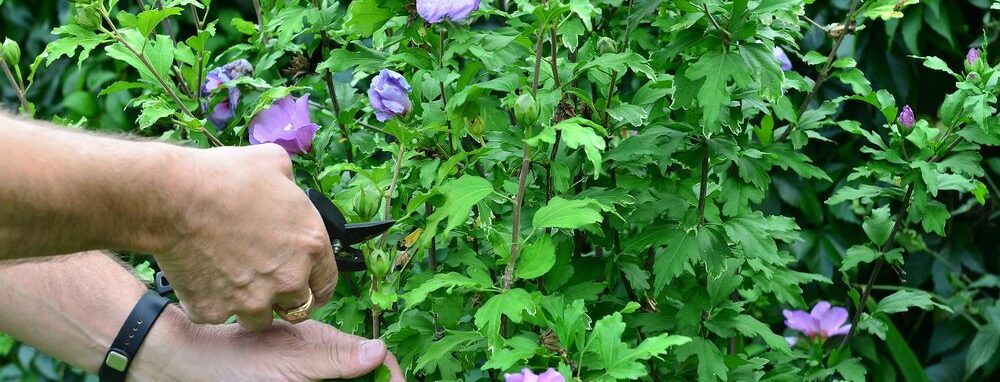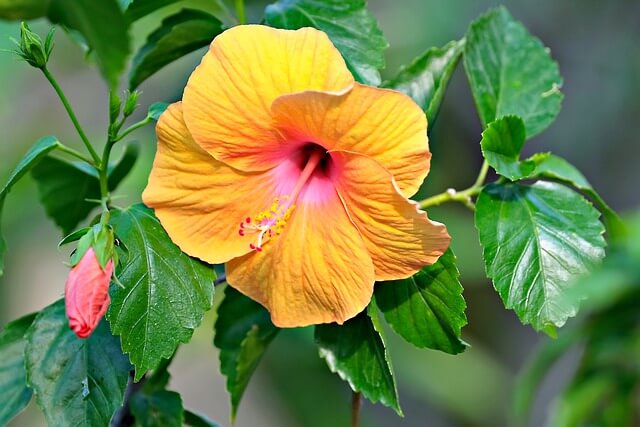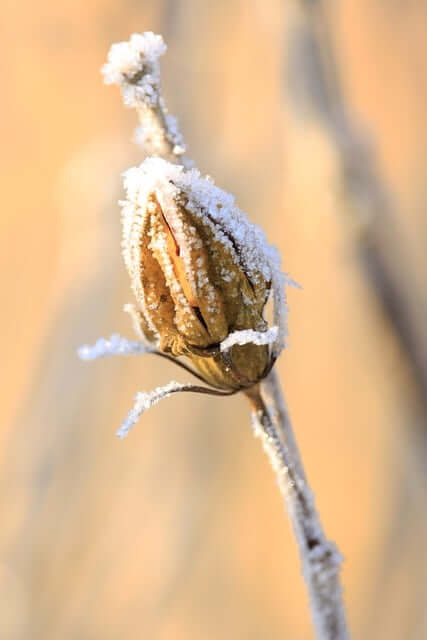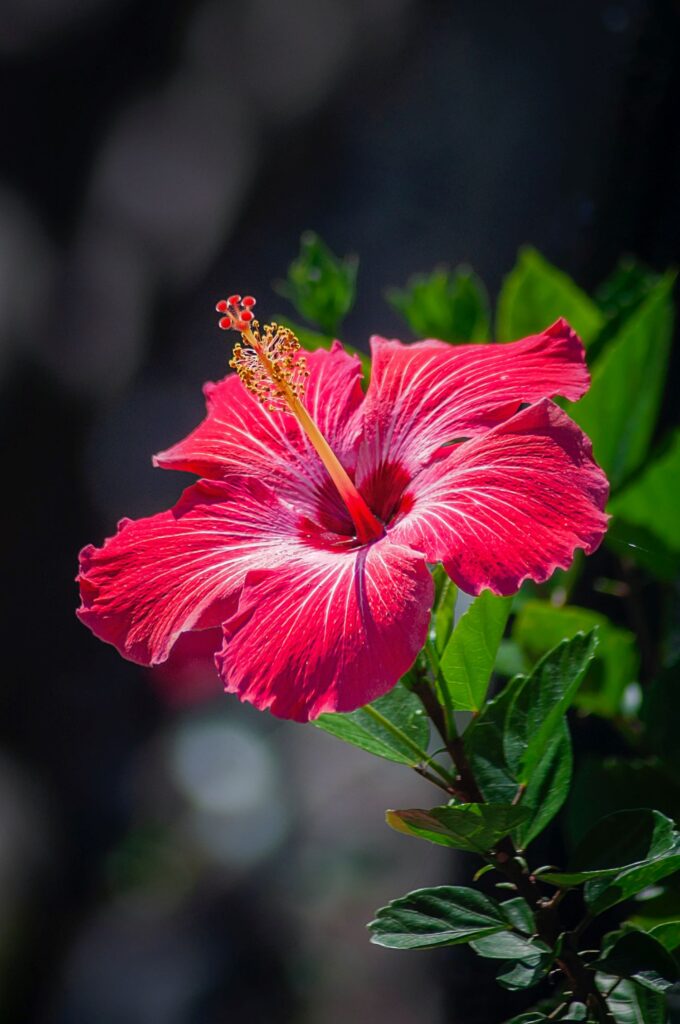Log in or create new account to save this product to your wishlist.

Pruning hibiscus: when, why, and how?
Pruning hibiscus is relatively straightforward, but there are some mistakes to avoid! Get the lowdown on pruning for healthy regrowth and abundant flowering.
🌱 All important maintenance moments for your lawn during the year. Leave your email and we will send you the lawn calendar for free.
Enter your email
Receive the lawn calendar in the mail
Enjoy a green lawn all year round!

- Order by 2PM = shipped today
- 250.000+ satisfied customers!
- 60 day satisfaction guarantee
As a proud owner of hibiscus plants, you naturally want them to look their best. And while it might seem counterintuitive, the path to a large, abundantly flowering hibiscus plant is to cut it back yearly.
- The ideal conditions for a hibiscus
- Why prune hibiscus?
- When to prune hibiscus
- Which month to prune hibiscus: check the species
- How often should I prune my hibiscus?
- Pruning a young hibiscus
- How to prune hibiscus: a step-by-step guide
- The tools you’ll need for pruning hibiscus
- Pruning hibiscus: aftercare
- Pruning hibiscus — common mistakes
- FAQs
These stunningly scented flowers brighten up every outdoor space. They favour sheltered spots away from direct, intense sunlight, so the hibiscus is ideal for bringing colour to a slightly shady corner.
This article is about pruning hibiscus, exploring why we do it and when, and an all-important step-by-step guide showing you how to prune your plant.
Ready? Let’s get pruning!
The ideal conditions for a hibiscus

Treat your hibiscus plant well, with regular care and pruning, and you’ll enjoy a beautiful bush with a long flowering window.
This stunning bush offers beautiful bell-shaped flowers that burst into a range of striking colours.
And while this plant is relatively slow-growing, it blooms on new wood. In other words, the blooms appear on branches formed earlier in the same year.
As mentioned, a bedding hibiscus enjoys moist, well-draining soil in a sunny, warm spot — ideally, it should be sheltered from the wind. These lovely plants also do well in pots as long as you give them plenty of peat-free, loam-based compost.
And hibiscus also makes a lovely house plant — just grow it out of direct, strong sunlight.
Why prune hibiscus?
As mentioned, hibiscus plants primarily bloom on new wood, so cutting off dead or diseased wood gives your plant more opportunity to flourish. Like all bushy plants, pruning promotes growth and health by allowing the plant to develop new branches.
Pruning stimulates new branches, resulting in fuller and more lush growth and flowering.
But while pruning is a once-a-year activity, I recommend dead-heading throughout the season to encourage more blooms.
When to prune hibiscus

The optimal window for pruning hibiscus is at the end of winter or early spring. This gives the plant enough time to recover and grow new shoots and branches, ready for flowering later in the year.
If early spring is particularly cold, wait a little longer, till later spring, once the chance of frost has passed. Frost can damage the pruning wounds, which can stunt new growth.
It is also possible to prune once the plant has finished flowering in autumn. Do this no later than October to minimise the risk of frost.
Which month to prune hibiscus: check the species

Each hibiscus variant prefers pruning during different months, so follow this guide:
- Hibiscus syriacus — early spring.
- Hibiscus moscheutos — autumn, after flowering
- Hibiscus rosasinensis — late winter/early spring
So, check your plant’s variety — if you’re unsure, try taking a photo with your smartphone and using a photo-recognition app; the iPhone has this baked into the Camera app.
Remember, every plant and garden is different, so it’s better to read the plant rather than the instructions. For example, if you have a shady garden, your plant might blossom later and stay flowering longer. Always wait until flowering has ended before pruning — and avoid frost!
How often should I prune my hibiscus?
Prune your hibiscus plant once a year.
Remember, hibiscus is slow-growing, so it won’t hurt to miss a year, although it’s better to be regular if possible.
If the bush is getting too big, cut it back, but wait until flowering is over. If you see many crossing or dead branches, cut them back — it’ll help improve the airflow around the plant, helping avoid disease.
Pruning a young hibiscus
The first time you prune a young hibiscus plant, cut it back by around a third, leaving two or three nodes on each branch, allowing new growth to emerge quickly.
Remove weak, leggy, or diseased growth and branches growing inwards towards the centre.
Rejuvenation pruning
If your plant is growing more slowly than it used to and producing fewer flowers, it’s a good idea to cut it back to around 75cm from the ground.
Cut the side branches back, leaving two to three nodes to help the plant recover with new growth.
How to prune hibiscus: a step-by-step guide

Luckily, pruning hibiscus is relatively straightforward. But it’s always helpful to know what you’re doing before making that first cut!
Here’s a handy step-by-step guide.
- Inspect the plant — look for diseased, damaged, and dead branches; these will need removing.
- Prepare your tools — always prune with sharp, clean tools. I recommend sharpening blunt pruning shears and treating the blade with an alcohol wash. This helps keep the cut clean and disease-free.
- Cut back all the dead and sick-looking branches — this helps the plant focus energy on new growth. Leave at least two or three nodes between the trunk and the cut, and cut just above the node (around 5mm from the node).
- Remove intersecting branches — cut inwardly growing branches and any branches that rub together. This helps airflow and light penetration, keeping the plant healthy and flourishing.
- Step back — take a step back from the bush regularly while pruning to review the new shape and size. And stop when you’re satisfied!
The tools you’ll need for pruning hibiscus
Here’s a list of the tools that will come in handy:
- Pruning shears with sharp blades — a blunt edge will tear at the plant, leaving a more extensive surface wound that could get infected. Always sharpen and clean the blades before pruning.
- Garden gloves — protect your hands from sharp branches and edges.
- Disinfecting spray — use this to clean your tools before and after use. This helps prevent the spreading of disease around your garden.
- Fertiliser — use a good general-purpose fertiliser after pruning to help the plant bounce back.
For more information, check out our article: How to Choose the Right Pruning Tools.
Pruning hibiscus: aftercare
All plants need a little TLC after pruning. Follow these steps to help your hibiscus successfully bounce back:
- Fertilise — feed your hibiscus with a good quality, slow-release fertiliser at least once a year and always after pruning. This provides nutrients for healthy growth and abundant flowering.
- Water — hibiscus plants need regular watering, especially during dry periods. Ensure the soil remains moist around the plant — but it should never be sopping wet: it’ll rot the roots.
- Frost — apply a good layer of mulch around the base of the plant during the winter to protect your hibiscus from frost. Use straw, fallen leaves, leaf mould, or well-rotted garden compost to help keep the roots warm and slowly release nutrients into the soil.
- Be patient — hibiscus plants are slow growers, so it may take a while to recover from pruning. Give it time, and don’t be tempted to over-fertilise. It will bounce back when it’s ready.
Pruning hibiscus — common mistakes
While pruning your hibiscus plant is relatively straightforward, avoid these mistakes:
- Cutting back too hard — over-cutting stresses the plant, hindering growth. Prune gradually, and avoid cutting more than one-third of the branch’s length.
- Cutting in the wrong place — always cut 5mm above a growing node. Trimming too far away from a node will stunt the growth and produce a leggy plant.
- Pruning at the wrong time — prune before the plant develops new growth and after flowering. Always avoid frost — give the plant at least three weeks after pruning before exposing it to frosty temperatures.
- Using dirty tools — this is the best way to infect your entire garden. Always keep your cutting tools sharp and clean to minimise the risk of infection.
FAQs
Prune your hibiscus once a year. These are relatively slow-growing plants, so it won’t hurt to skip a year. However, don’t leave it for longer than two years; otherwise, the plant’s growth and flowering will suffer.
Remove dead and diseased branches and any inward or intersecting branches. Cut by up to a third of the existing size using clean pruning shears. Leave two or three nodes on the branch, cutting 5mm above the node.
If your hibiscus plant has stopped flowering or isn’t blooming as much as it used to, it’s time for rejuvenation pruning. Cut the plant back to 75cm from the ground, and cut each branch, leaving two to three buds on each branch. Then, fertilise and water well. When the plant bounces back, it will burst back into flower
Any questions?
I hope you’ve got all the info you need for pruning hibiscus plants, but if you have any questions, don’t hesitate to email us.
Alternatively, leave a comment in the Comments section below or check out our comprehensive Help & Advice section.
Thanks for reading!
-
Orchids: A Complete Guide on How to Care for ThemWant to give your orchid the best possible care? Discover essential tips from placement to watering and pruning. Learn everything you need to know!Read more
-
Growing Wisteria Made Simple: From Planting to Perfect BloomsWith blossoms like a purple waterfall, Wisteria sets an almost magical and colourful mood. If you want to grow this beauty in your garden, you’ll need a bit of patience. Don’t worry, it will most definitely pay off.Read more
-
How to Build a DIY Greenhouse: A Practical Guide for Smart SpendersImagine extending your growing season throughout the year, nurturing tender plants regardless of the weather, and creating a personal garden sanctuary. This is precisely what a DIY greenhouse offers you. Let’s learn how to build one.Read more
-
How to Grow Eucalyptus in British GardensWith a little love and care, eucalyptus trees can thrive in English gardens. Since they don’t germinate well without proper help, there are not considered invasive. So, there is no reason not to plant them if you enjoy their looks.Read more
-
Transform Your Garden with All-Year-Round Flowering PlantsDid you know you can enjoy blooming flowers even in January? With the right selection of all year round plants, there’s no need to wait until spring to add some colour to your garden.Read more
-
How to Create a Butterfly Garden: A Simple Guide for British GardensThe UK's butterfly population includes 59 different species. These beautiful winged creatures face a steady decline because of habitat loss, pollution and changing weather patterns. Your garden can become a vital link between nature reserves and natural habitats. Let’s explore how.Read more
-
Volcanic Rock Dust for Your Garden—Application and TipsDid you know that volcanic rock dust is a brilliant organic soil improver? This article explains exactly what it's good for and how to use it properly.Read more
-
How to Use Landscape Fabric ProperlyIf weeds or erosion in your garden are troubling you, landscape fabric might be the solution. We’ll explain how and when to use it properly, just keep on reading.Read more
Leave a comment
Your answer will be displayed on the site and the interested party will be notified by email.
Leave a comment
Have a question or want to share your experience? Leave us a comment.

- Order by 2PM = shipped today
- 250.000+ satisfied customers!
- 60 day satisfaction guarantee

- Order by 2PM = shipped today
- 250.000+ satisfied customers!
- 60 day satisfaction guarantee

🌱 All important maintenance moments for your lawn during the year. Leave your email and we will send you the lawn calendar for free.
Enter your email
Receive the lawn calendar in the mail
Enjoy a green lawn all year round!






















Comments (0)
There are no comments yet. Well then, what are you waiting for to
Be the first to write your comment!inaugurate this pretty page?
Do you have some comments?